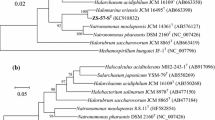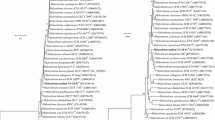Abstract
Halophilic archaeal strain GX31T was isolated from a marine solar saltern of China. The cells of the strain were rod-shaped and lysed in distilled water, stain Gram-negative and formed red-pigmented colonies. It was neutrophilic, and required at least 0.9 M NaCl and 0–1.0 M MgCl2 for growth under the optimum growth temperature of 37 °C. The major polar lipids of the strain were phosphatidylglycerol (PG), PG phosphate methyl ester, PG sulphate, and two major glycolipids chromatographically identical to sulphated mannosyl glucosyl diether (S-DGD-1) and mannosyl glucosyl diether (DGD-1), respectively. Trace amounts of two unidentified lipids were also detected. On the basis of 16S rRNA gene sequence analysis, strain GX31T was closely related to the members of Halobellus of the family Halobacteriaceae with similarities of 94.1–98.7 %. Strain GX31T showed 89.8–95.4 % of the rpoB′ gene similarity to the members of Halobellus. The DNA G+C content of strain GX31T was 66.8 mol%. Strain GX31T showed low DNA–DNA relatedness with two most related members of the genus Halobellus. The phenotypic, chemotaxonomic and phylogenetic properties suggest that strain GX31T represent a novel species of the genus Halobellus, for which the name Halobellus litoreus sp. nov. is proposed. The type strain is GX31T (=CGMCC 1.10387T = JCM 17118T).

Similar content being viewed by others
References
Cui HL, Zhou PJ, Oren A, Liu SJ (2009) Intraspecific polymorphism of 16S rRNA genes in two halophilic archaeal genera, Haloarcula and Halomicrobium. Extremophiles 13:31–37
Cui HL, Gao X, Yang X, Xu XW (2010) Halorussus rarus gen. nov., sp. nov., a new member of the family Halobacteriaceae isolated from a marine solar saltern. Extremophiles 14:493–499
Cui HL, Yang X, Gao X, Xu XW (2011) Halobellus clavatus gen. nov., sp. nov. and Halorientalis regularis gen. nov., sp. nov., two new members of the family Halobacteriaceae. Int J Syst Evol Microbiol 61:2682–2689
Cui HL, Yang X, Mou YZ (2011) Salinarchaeum laminariae gen. nov., sp. nov.: a new member of the family Halobacteriaceae isolated from salted brown alga Laminaria. Extremophiles 15:625–631
Cui HL, Yang X, Zhou YG, Liu HC, Zhou YG, Dyall-Smith ML (2012) Halobellus limi sp. nov. and Halobellus salinus sp. nov., isolated from two marine solar salterns in Australia and China. Int J Syst Evol Microbiol 62:1307–1313
De Ley J, Cattoir H, Reynaerts A (1970) The quantitative measurement of DNA hybridization from renaturation rates. Eur J Biochem 12:133–142
Huss VA, Festl H, Schleifer KH (1983) Studies on the spectrophotometric determination of DNA hybridization from renaturation rates. Syst Appl Microbiol 4:184–192
Marmur J, Doty P (1962) Determination of the base composition of deoxyribonucleic acid from its thermal denaturation temperature. J Mol Biol 5:109–118
Minegishi H, Kamekura M, Itoh T, Echigo A, Usami R, Hashimoto T (2010) Further refinement of Halobacteriaceae phylogeny based on the full-length RNA polymerase subunit B′ (rpoB′) gene. Int J Syst Evol Microbiol 60:2398–2408
Oren A, Ventosa A, Grant WD (1997) Proposed minimal standards for description of new taxa in the order Halobacteriales. Int J Syst Bacteriol 47:233–238
Owen RJ, Pitcher D (1985) Current methods for estimating DNA base composition and levels of DNA–DNA hybridization. In: Goodfellow M, Minnikin DE (eds) Chemical methods in bacterial systematics. Academic Press, London, pp 67–93
Qiu XX, Mou YZ, Zhao ML, Zhang WJ, Han D, Ren M, Cui HL (2013) Halobellus inordinatus sp. nov., from a marine solar saltern and an inland salt lake of China. Int J Syst Evol Microbiol. doi:10.1099/ijs.0.053066-0
Stackebrandt E, Goebel BM (1994) Taxonomic note: a place for DNA–DNA reassociation and 16S rRNA sequence analysis in the present species definition in bacteriology. Int J Syst Bacteriol 44:846–849
Tamura K, Peterson D, Peterson N, Stecher G, Nei M, Kumar S (2011) MEGA5: molecular evolutionary genetics analysis using maximum likelihood, evolutionary distance, and maximum parsimony methods. Mol Biol Evol 28:2731–2739
Zhang WJ, Han D, Qiu XX, Zhao ML, Mou YZ, Li ZR, Cui HL (2013) Halobellus rarus sp. nov., a halophilic archaeon from an inland salt lake of China. Antonie Van Leeuwenhoek 104(3):377–384
Acknowledgments
This work was supported by the National Natural Science Foundation of China (No. 31370054), the grant from China Ocean Mineral Resources R&D Association (COMRA) Special Foundation (DY125-15-R-03), the Qinglan Project of Jiangsu Province and a project funded by the Priority Academic Program Development of Jiangsu Higher Education Institutions (PAPD).
Author information
Authors and Affiliations
Corresponding authors
Additional information
The GenBank/EMBL/DDBJ accession numbers for the 16S rRNA gene and the rpoB′ gene sequences of strain GX31T are GU951426 and KF241979, respectively. Phase-contrast micrograph and thin-layer chromatogram of strain GX31T, maximum-parsimony and maximum-likelihood phylogenetic trees based on 16S rRNA gene and the rpoB′ gene sequences of strain GX31T and some related haloarchaea are available as supplementary materials.
Electronic supplementary material
Below is the link to the electronic supplementary material.
Rights and permissions
About this article
Cite this article
Zhao, ML., Qiu, XX., Zhang, WJ. et al. Halobellus litoreus sp. nov., a Halophilic Archaeon Isolated from a Chinese Marine Solar Saltern. Curr Microbiol 68, 156–160 (2014). https://doi.org/10.1007/s00284-013-0457-8
Received:
Accepted:
Published:
Issue Date:
DOI: https://doi.org/10.1007/s00284-013-0457-8




